E-bikes have transformed into more than just gadgets to help you get around. Now, they're speed demons that can go toe-to-toe with motorbikes. It’s 2025, and these speedy machines have gotten a huge boost from better motors, more powerful batteries, and sleek designs that cut through the air like a knife. Let’s dive into the […]

Mastering Motorcycle Cornering Tips: Ultimate Guide for Riders 2025
Cornering is one of the most exhilarating aspects of motorcycle riding. Every rider needs to learn and master the essential motorcycle corning tips.
Because it is an important skill not only to make your riding safe, but also for your riding enjoyment.
Whether you're navigating tight mountain curves or sweeping bends on a track, you will need it.
This guide provides detailed tips and techniques to help you improve your cornering skills and confidence.
Table of Contents
Motorcycle Cornering Tips - Step by Step
1. Understand the Basics of Cornering
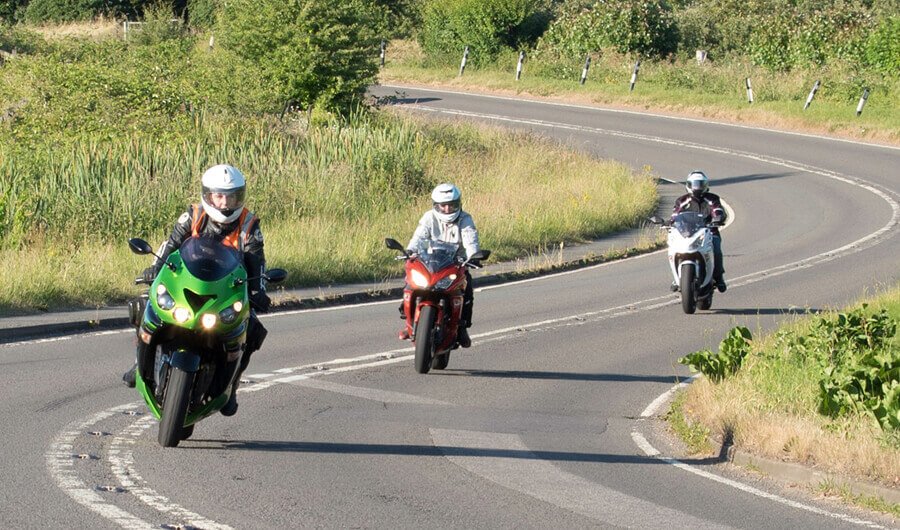
know the basics of cornering is the first step
Cornering involves balancing various factors: speed, lean angle, throttle control, and body position.
The primary goal is to maintain your stability and control while maneuvering through a curve.
Here are the key fundamentals:
- Look where you want to go: Your motorcycle follows your eyes. So, when approaching the corner, remember to focus on the exit of the corner, not on obstacles.
- Smooth inputs: Jerky movements in the throttle, brakes, or handlebars can destabilize your bike. You should practice more about smooth transitions, especially for beginner riders.
- Maintain balance: A motorcycle stays upright due to gyroscopic forces and your control inputs. Ensure even weight distribution.
2. Prepare Before Entering the Corner
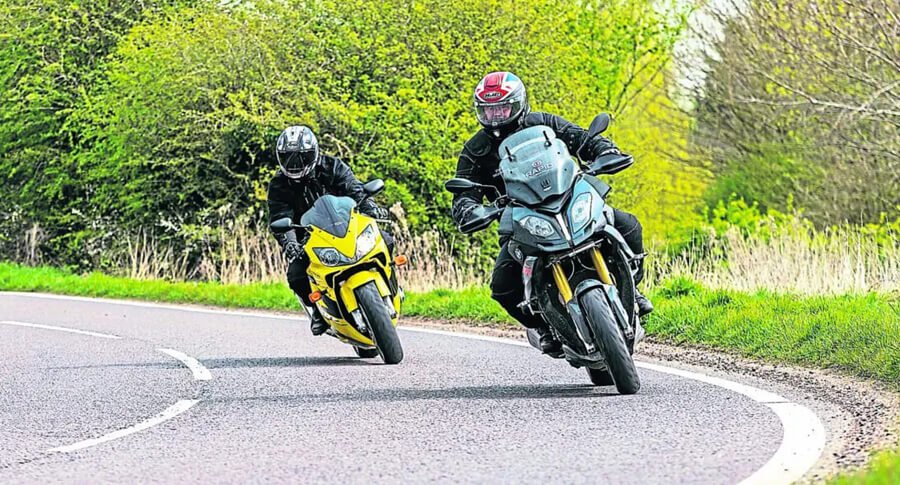
Prepare before entering the corner - Motorcycle Cornering Tips
Preparation starts well before you enter the corner.
Many novice motorcycle riders are not aware of this detail. This causes them to rush into the turn after entering the curve, which can result in a failed turn.
This can cause damage to the rider’s body or the motorcycle, and in serious cases, tragedy may occur.
Follow these steps to set yourself up for success:
- Assess the corner: Identify the type of corner—tight, sweeping, or hairpin before you make the next move. Besides, you should also look for any potential hazards, such as gravel or wet patches.
- Adjust speed: Ride at a slow speed so that you can safly reach and entry the corner. Use both brakes gently but effectively.
- Position yourself: Align your motorcycle in the correct lane position. On right-hand corners, stay closer to the left. For left-handers, position yourself closer to the right.
- Choose your line: Visualize the best path through the corner. Aim for a smooth arc that avoids sharp changes in direction.
3. Corner Entry
The entry phase is critical, so be careful when entering the corner. If you get this wrong, the rest of the corner may become challenging, or even fail. Here's how to nail it:
- Ease off the brakes: Once you've slowed down, smoothly release the brakes as you lean into the turn. Remember again, release it smoothly! Holding the brakes can upset the bike's balance.
- Countersteer: Push the handlebar in the opposite direction of the turn. For a left turn, push the left handlebar; for a right turn, push the right. This action initiates the lean.
- Maintain a steady throttle: A neutral or slightly positive throttle keeps the bike stable. Besides, you should prevent it from standing up mid-corner.
4. Mid-Corner Techniques
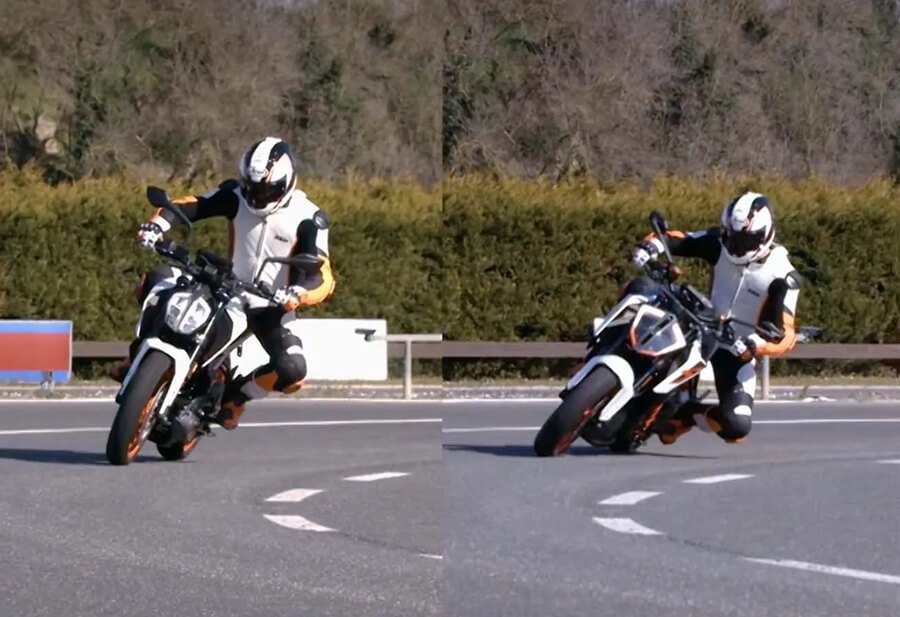
Pay attention to the body position during mid-cornering
Once you're in the turn, the focus shifts to maintaining balance and control:
- Body position: Shift your weight slightly toward the inside of the turn. What's more, remember to keep your upper body relaxed and your head aligned with the horizon.
- Lean angle: Your tires will provide a stable grip for you and your motorcycle, just trust it. Modern motorcycle tires are designed to handle significant lean angles safely.
- Throttle control: Apply smooth, gradual throttle to maintain momentum. Avoid abrupt changes that can unsettle the bike.
5. Corner Exit
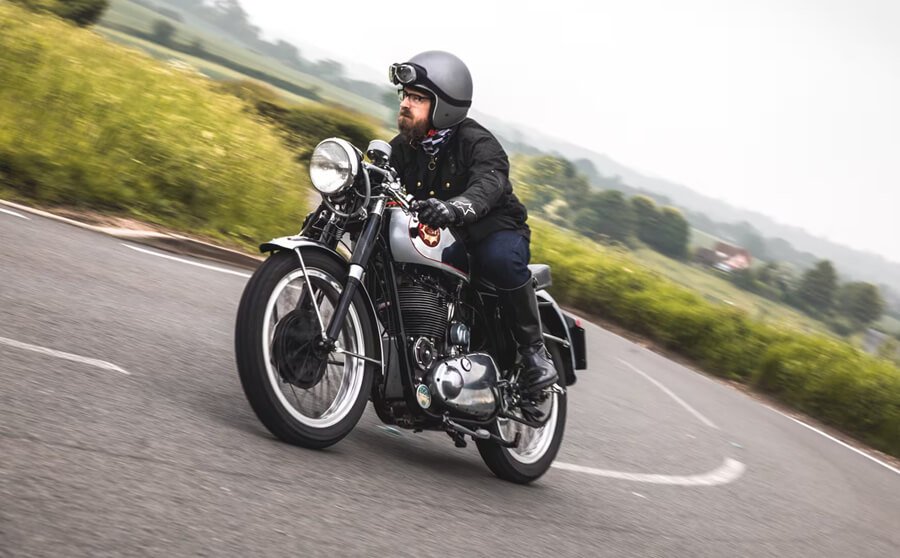
Look ahead after you exit the corner
Exiting the corner correctly sets you up for the next stretch of road. Pay attention to the following details:
- Look ahead: Focus on the road beyond the corner when you are about to exit the corner. You need to watch out for upcoming changes, like vehicles, people, obstacles, animals, or the next corner.
- Roll on the throttle: When you have exited the corner, you can gradually increase the throttle. Then the motorbike will straighten again. This helps transfer weight to the rear wheel, enhancing traction.
- Adjust the handlebar's direction: Pull the handlebars back appropriately according to the conditions of the curve. Make sure the vehicle's forward direction is always parallel to the road direction.
- Stand the bike up: As you exit, bring the motorcycle back to an upright position.
The aboves are the basic cornering tips you must master, especially for beginner riders.
Advanced Motorcycle Cornering Techniques
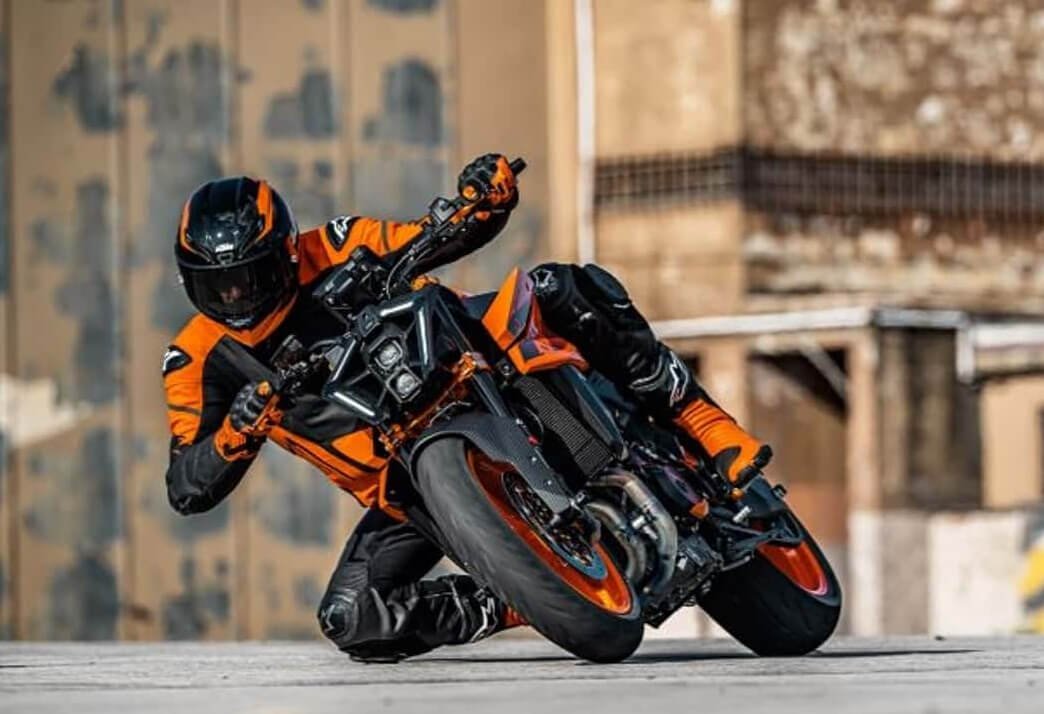
A man is trying advanced motorcycle cornering techniques
Once you have mastered the basic turning skills, you can try some advanced turning techniques. They will take your cornering skills to the next level.
Mastering cornering is essential for safe and confident riding. Here are some advanced techniques to improve your cornering skills:
- Trail Braking: This involves gradually releasing the front brake as you lean into a corner. Trail braking helps maintain stability, adjusts your speed smoothly. Besides, it shifts weight onto the front tire for better grip. You can start by practicing on gentle curves if you are just start learning advanced cornering skills. Then gradually increase the lean angle as your confidence grows.
- Body Positioning: Shift your body weight to optimize traction and balance. Move your upper body inside the turn, aligning your head and shoulders with the bike's lean. Besides, keep your outside knee pressed against the tank for stability. And, grip the handlebars lightly to avoid upsetting the bike's balance.
- Hanging off: For sharper corners or high-speed turns, shift more of your body off the bike toward the inside. This can reduce the lean angle needed for the same speed.
- Throttle Control: Keep a smooth throttle application through a corner. This ensures steady acceleration and weight transfer to the rear tire, enhancing grip. More importantly, you should avoid abrupt inputs, otherwise can unsettle the bike mid-turn.
- Counter-Steering: Push gently on the inside handlebar (e.g., right bar for a right turn) to initiate lean. Counter-steering is the most effective way to change direction quickly and precisely at higher speeds.
- Look Through the Corner: Your bike follows your eyes. Focus on the exit point of the curve, not the road directly in front of you. This helps maintain a smooth line and prepares you for upcoming changes.
- Late Apexing: Aim for a "late apex," entering the corner slightly wide and turning in later. This allows a straighter exit line, better visibility, and improved cornering speed.
Practice these techniques on familiar roads or controlled environments, gradually building proficiency. Confidence and precision come with time and repetition. Stay relaxed, and always prioritize safety.
Common Mistakes to Avoid
Even experienced riders make mistakes, so pay attention while cornering. Avoid these common pitfalls:
- Target fixation: Staring at obstacles can cause you to ride straight toward them. Always look where you want to go.
- Entering too fast: Overestimating your speed can lead to wide exits or loss of control. Always err on the side of caution.
- Abrupt inputs: Sudden throttle, braking, or steering changes can destabilize the bike, especially mid-corner.
- Overweight: Knowing how much your motorcycle can carry and do not exceed its weight limit. Being overweight can make it harder to control your motorcycle while cornering.
Practice Makes Perfect
Improvement comes with consistent practice. These are some tips you can consider when practicing:
- Start slow: Focus on technique rather than speed when you are a rocky. With time going on and you practice more, you can build your confidence gradually.
- Use training areas: Practice in controlled environments if you have not mastered the cornering skills. For example, the empty parking lots or track days.
- Learn from others: Join some riding groups and learn from experienced riders is also considerable. Also, you can take advanced riding courses to gain new perspectives.
- Analyze your rides: Reflect on your cornering performance after each try. Then you can identify some areas for improvement.
- Find a Teacher: If necessary, find a rider who is experienced to teach you. You can take some advanced riding courses or find a friend to help you gain new perspectives. You can communicate with him through motorcycle intercoms, and give you live advice.
Safety First
Cornering can be dangerous if you have not done it correctly. So, always prioritize safety while corning.
- Wear proper gear: Invest in quality helmets, gloves, jackets, pants, and boots. Protective gear can save your life in case of a fall.
- Inspect your bike: Regularly check tire pressure, suspension, and brakes.
- Abandon Your Dangerous Riding Habits: Never do dangerous riding in the corners. It is not only harmful to yourself but also irresponsible to other road participants.
- Ride within your limits: Avoid pushing yourself too far, especially in unfamiliar areas.
- Be weather-aware: Rain, snow, or gravel significantly reduces grip. Adjust your riding accordingly.
What is the speed for safe cornering?
The safe speed for cornering depends on several factors. These include the sharpness of the turn, road conditions, and your bike's handling capabilities.
A general rule is, when approaching the corner, control the motorcycle at a speed that you think you can control. Besides, slow down before the turn, then maintain or slightly increase speed as you lean through it.
On dry roads with good grip, most riders corner safely between 30-50 km/h (20-30 mph) on moderate bends. Always adjust for wet, sandy, or uneven surfaces.
Ride within your limits and always prioritize stability over speed.
Conclusion
Mastering motorcycle cornering tips is a journey, not a destination. You need to understand the principles, practice consistently, and stay safe.
Whether you're a beginner or an experienced rider, don't ignore these tips. Because they will help you tackle corners with confidence and finesse. Also, they can enhance your skills and bring you more riding thrills.
Remember, the road is unpredictable. So, stay alert, ride responsibly, and savor the ride.

With over 10 years of experience working on cars and trucks Item Training Supervisor Richard Reina is known around the office as one of our technical experts & real an "automobile person".
His rate of interest began, in his very own words, "at the age of two when his father educated him the distinction in between a Chevy and a Ford. Since then it's been cars regularly."
As a serious lover of practically all things with a motor Richard can address nearly any kind of inquiry related to car upkeep, fixing, or restoration & is a fact professional in electric motor background.
Many riders who aren't so tall or ladies just starting to ride bikes need to pick out the best Motorcycles for Short Riders and Women. They gotta look for three key things: a seat that's not too high up, a bike that's not too heavy, and something that looks good enough to give them confidence. […]
As we accelerate into 2025, motorbikes are getting a serious tech upgrade. They’re all about safer rides and more fun on the road. Even if you’re a pro or just starting, kitting out your two-wheeler with cool tech stuff is a game-changer. Check out these ten top motorcycle gadgets each motorcyclist will want in 2025. […]
Getting around the city every day can be super annoying. You've got traffic like molasses nowhere to park, fuel prices through the roof, and buses stuffed like sardine cans make heading to the office a real pain. For loads of folks, getting a motorcycle is a pretty slick move—they’re nimble, cost-effective, and perfect for squeezing […]
Rider safety demands motorcycle helmets. Yet, riders still clash over picking full-face vs open-face helmets. Full-face ones take the win for protecting in crashes, but open-face models charm folks who want cool looks better air, and that old-school vibe. This guide dives into the latest research, technological advancements, and real-world insights to help you decide […]
Fodsports FX 60C vs FX30C Pro: What's new techs are the FX 60C bringing to us? Fodsports is a brand worth-mention for helmet communication and video recording. This brand has established itself as a key player with its innovative Bluetooth camera intercom systems. Recently, Fodsports has released a new camera intercom, the FX 60C. How […]

